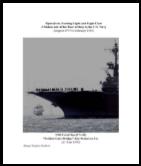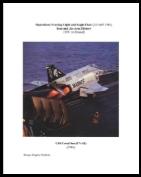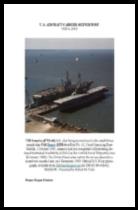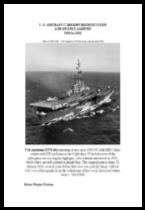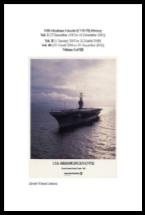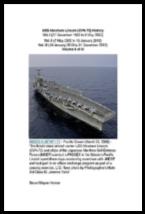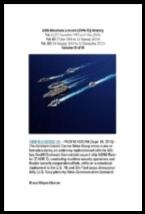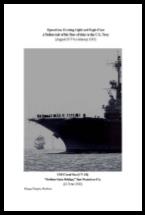






|
USS MIDWAY (CVA-41) 2nd VIETNAM COMBAT CRUISE, AWARDS AND CASUALTY REPORTS - 8th WestPac” Deployment (16 April to 6 November 1971) CHAPTER XXIV Appendix III |
|
USS Midway (CVA-41) underway on 20 June 1963, with F-3 Demon, F-4B Phantom II and F-8 Crusader jet fighters on her flight deck. The two Crusaders parked furthest forward are from Fighter Squadron 24 (VF-24). Photographed by PH1 J.D. Osborne. Official U.S. Navy Photograph, from the collections of the Naval Historical Center (# NH 97632). NS024123. NHC. |

|
A Sailors tale of his Tour of duty in the U.S. Navy (August 1977 to February 1983) Operation Evening Light and Eagle Claw - 24 April 1980
Book - ISBN NO. 978-1-4276-0454-5 EBook - ISBN NO. 978-1-329-15473-5
Operations Evening Light and Eagle Claw (24 April 1980) Iran and Air Arm History (1941 to 1980)
Book ISBN NO. xxxxxxxxxxxxx EBook ISBN NO. 978-1-329-19945-3
U. S. AIRCRAFT CARRIER SHIP HISTORY (1920 to 2019)
Book - ISBN NO. 978-1-4276-0465-1 EBook - ISBN NO. 978-1-365-25019-4 Library of Congress Control Number: 2008901616 (Book Version)
U. S. AIRCRAFT CARRIERS REDESIGNATED AND OR RECLASSIFIED (1953 to 2016)
BOOK - ISBN NO. 978-1-4276-0452-1 EBook - ISBN NO. 978-1-365-25041-5 Library of Congress (Book Version) 2008901619
ENERGY QUEST AND U. S. AIRCRAFT CARRIER DEPLOYMENT HISTORY INVESTMENT CAPITAL REQUIRED TO PUBLISH 55 EIGHTH HUNNDRED PAGE BOOKS, EBOOKS & CD’s (48 Navy Books)
Book - ISBN NO. To Be Announced EBook - ISBN No. 978-1-365-26038-4
USS Abraham Lincoln (CVN-72) History Vol. I of III (27 December 1982 to 6 May 2003)
Book Vol. I of IV ISBN: TBA EBook Vol. I of IV ISBN: 978-1-365-73794-7
USS Abraham Lincoln (CVN-72) History Vol. II of III (7 May 2003 to 13 January 2010)
Book - ISBN NO. To Be Announced EBook - ISBN NO. 978-1-365-74027-5
USS Abraham Lincoln (CVN-72) History Vol. III of III (14 January 2010 to 31 December 2012)
Book - ISBN NO. To Be Announced EBook - ISBN No. 978-1-365-74145-6
USS Coral Sea CV-42 CVB-43 CVA-43 and CV-43 History and Those Aircraft Carriers Operating with Coral Sea During Her Tour of Service CONSTRUCTION to LAUNCHING and EARLY JET AIRCRAFT DEVELOPMENT (10 July 1944—2 April 1946) and a Tour of Duty in the U. S. Navy (August 1977 to February 1983)
ISBN: 9781434382917
|
|
USS MIDWAY (CVA-41) 2nd VIETNAM COMBAT CRUISE, AWARDS AND CASUALTY REPORTS - 8th WestPac” Deployment (16 April to 6 November 1971) CHAPTER XXIV Appendix III
USS Midway (CVA-41) Air Wing: Carrier Air Wing Five (CVW)-5
Eighth “Westpac” deployment and Second Vietnam Combat Cruise (KIAs, killed due to operational loss and POWs) KIA/MIAs/POWs
Eighth “WestPac” deployment, operating with the Pacific Fleet and the 7th Fleet, her eighth South China Sea, on her second Vietnam Combat Cruise on “Yankee Station” in the Far East Summary (16 April to 6 November 1971). CHAPTER XXIV Appendix IV
“On 6 November 1971, USS Midway (CVA-41) with Rear Admiral J. L. Butts, Jr., Commander Carrier Division ONE, arriving aboard to assume duties of Carrier Division Commander on 15 April 1971 and at 0001 16 April activated CTG 17.3, with Captain F. T. Hemer as Chief of Staff Carrier Division One, and Commander Captain R. B. Rutherford, Commander, Carrier Air Wing Five (CVW-5) embarked arrived Naval Air Station, Alameda, California 16 April 1971, with Captain William Lawrence Harris, Jr., USNA '46, assumed command during a change of command ceremony aboard when Midway stood down from air operations on 10 July 1971, relieving Captain Eugene James Carroll, Jr., NAVCAD, 25th Commanding Officer, serving from January 31, 1970 - July 10, 1971, and Captain G. E. Jacobssen Jr., as Executive Officer, ending her eighth “WestPac” deployment, operating with the Pacific Fleet and the 7th Fleet, her eighth South China Sea, on her second Vietnam Combat Cruise, conducting Operational Readiness Exercise (ORE); Yankee Station” responsibility again on 30 June 1971, on “Yankee Station,” conducting Combat Missions, Special Operations, Single Carrier Operations and Air Operatins on four line period in the South China Sea in the Gulf of Tonkin on “Yankee Station,” conducting Exercise “Autumn Flower;” with the Japanese Defense Force and with Okinawa, Exercise “Commando Mirage” en route “Yankee Station” in the Far East. In April 1971, Midway began her sixteenth deployment 13,000 tons heavier than her original full pay load figure. When she arrived off the coast of Vietnam, her Airwing commenced strikes and flew over 6,000 sorties in support of allied operations on four line periods totaling 69 days. Almost immediately, upon reaching open sea, Midway encountered rough seas, durinng which time the forward starboard sponsor suffered extensive damage and it was decided to put into Pearl Harbor to effect repairs. The five days required to repair Midway’s sponson precluded participation in the scheduled Operational Readiness Exercise (ORE). Midway pullied in for a port of call at Pearl Harbor, Hawaii on 26 April 1971. During 16 and 17 April the forward starboard sponsor suffered extensive damage do to rough seas upon reaching open sea and it was decided to put into Pearl Harbor to effect repairs. The five days required to repair Midway’s sponson precluded participation in the scheduled ORE. Midway made a port of call at Pearl Harbor, Hawaii from 26 to 30 April 1971. Rear Admiral Butts was honored by the visit of CINCPACFLT, Admiral and Mrs. Bernard A. Clarey, Vice Admiral and Mrs. D. C. Richardson and Lieutenant General and Mrs. G. A. Corcoran on 29 April 1971. Midway departed Pearl Harbor on 1 May. During the period 26 April to 1 May the sponson damage was corrected and Midway was ready to put to sea. Midway chopped to operational control of Commander Seventh Fleet on 7 May 1971.C1A Detachment, known as “Easy Way Airlines” was conceived, born and in full carrier operation in less than two weeks. During Midway’s conversion, all aviation fuel tanks were converted for jet fuel only and it was planned that only the turbojet powered C2A COD aircraft would be utilized. While en route to the Western Pacific word was received that all CVA’s would be required to carry one C1A aircraft for logistics, mail and cargo flights. Midway accepted her own C1A on 12 May 1971. The original “Cod Squad” crews conducted field quals at NAS Cubi Point on 14 to 15 May 1970. Midway made a port of call at Subic Bay, Republic of Philippines from 13 to 15 May 1971, departing for “Yankee Station,” to conduct Combat Missions, Special Operations and Single Carrier Operations, on her first line period on “Yankee Station,” in the South China Sea in the Gulf of Tonkin. Midway C1A Detachment, known as “Easy Way Airlines” flew the first scheduled logistics flight on 18 May 1970 (initial carrier quals were conducted on 16 to 17 May 1971). Midway’s first day on the line, Triple zero (000) met every scheduled commitment throughout the deployment. Being based at Da Nang Air Base, RVN, careful, thorough fuel planning and management by flight crews was mandatory in conducting operations aboard ship without a fueling capability. This professional approach to airmanship was evident during every line period. Easy Way Airlines would begin displaying Midway’s flag throughout many foreign airports including Japan. Philippines, Okinawa, Taiwan, South Viet Nam, and Thailand, before C1A Triple Zero would return to San Francisco, California with Midway and will continue its operations out of NAS Alameda, California. Midway returned to Vietnam and on 18 May 1971, after relieving USS Hancock (CV-19) on “Yankee Station,” to conduct Combat Missions, Special Operations and Single Carrier Operations, on her first line period in the South China Sea in the Gulf of Tonkin. Vice Admiral Maurice F, Weisner, Commander Seventh Fleet visited Midway on 22 May 1971. After an eight day line period on “Yankee Station,” conducting combat missions, Special Operations and single carrier operations, Midway first line period on “Yankee Station,” in the South China Sea in the Gulf of Tonkin. Midway stood down on 26 May 1971 for a one day rest. Midway heralded the first of numerous typhoons that required the ship to divert from “Yankee Station” from 28 to 30 May 1971. Typhoon Dinah forced the ship to head south for the safety of calmer Waters. On 30 May 1971 the Chief of Naval Operations, Admiral Elmo R. Zumwalt, Jr. arrived for a short visit aboard Midway. After conferring with Rear Admiral Butts and Captain Carroll, he reenlisted 25 men into the Navy, met with the junior officers in the wardroom and held a forum over Midway’ s TV station, KMID. General Creighton Abrams, Commander Military Assistance Command Vietnam, and Vice Admiral Weisner arrived aboard toured the ship Midway for a four hour period on 2 June 1971. General Abrams and was briefed on operations. Before leaving he gave a short overview of S. E. Asia operations over KMID. On 4 June 1971, Prince Manghra Souvanna Phouma, Prince of Laos to South Vietnam arrived aboard Midway for a short visit. Midway departed “Yankee Station” on 10 June 1971, returning to Vietnam on 18 May 1971, she relieved USS Hancock (CV-19) on “Yankee Station” the same day, conducting Combat Missions, Special Operations and Single Carrier Operations, on her first line period in the South China Sea in the Gulf of Tonkin from 18 May to 9 June 1971 (23-days). With the exception of the stand-down period of 26 to 27 May and evasion of typhoon Dinah from 28 to 30 May 1971, the first line period was completed as scheduled and without mishap. While en route Yokosuka, Japan, Midway conducted Exercise “Blue Sky" with the Taiwan Defense Force while passing the Island on 11 June 1971. On 18 June 1971, Midway was privileged to be the host ship for the Seventh Fleet Change of Command ceremony as Vice Admiral Maurice F. Weisner, USN, was relieved by Vice Admiral William P, Mack, USN. Admiral Bernard A. Clarey addressed the gathering as guest speaker. Midway arrived Yokosuka, Japan on 14 June 1971. Vice Admiral W. P. Mack relieved Vice Admiral M. F. Weisner as Commander Seventh Fleet on 18 June 1970 aboard Midway and Commander M. D. Cunningham relieved Captain G. E. Jacobssen Jr., as Executive Officer of Midway from 31 January 1970 to 22 June 1971, making a port of call at Yokosuka, Japan from 14 to 24 June 1971, departing to conduct Combat Missions and Special Operations, on her second line period on “Yankee Station” in the South China Sea in the Gulf of Tonkin on 25 June 1971. In the Japanese port city of Yokosuka in early June 1971, the “Action Group” aboard Midway traveled to the Shunko Gakuen Orphanage where they painted and cleaned the building and its grounds. Then in keeping with the People to People intent of the program, the group headed by Chaplin Ben Mack, distributed a number of gifts, including basketballs, volleyballs, dolls, and clothing to the pleased youngsters, who were treated the following day to a tour and a fried chicken dinner aboard. Midway assumed “Yankee Station” responsibility again on 30 June 1971, conducting Exercise “Autumn Flower;” with the Japanese Defense Force and with Okinawa, Exercise “Commando Mirage” en route “Yankee Station” in the South China Sea in the Gulf of Tonkin. Nature again forced a stand-down for Midway on 5 July 1971. One hundred-twenty knot winds of Typhoon Harriet required the ship to run south before resuming air operations on 6 July 1971. On 10 July 1971, Midway stood down from air operations. Captain William Lawrence Harris, Jr., USNA '46, assumed command during a change of command ceremony aboard Midway on 10 July 1971, relieving Captain Eugene James Carroll, Jr., NAVCAD, 25th Commanding Officer, serving from January 31, 1970 - July 10, 1971. Rear Admiral John L, Butts, Jr., USN, Commander Carrier Division ONE was the guest speaker. An officer and enlisted reception followed the ceremony. The Honorable A. H. Meyer, United States Ambassador to Japan and Vice Admiral Mack, USN visited Midway on 12 July 1971. Air Operations were again interrupted by nature - this time in the form of tropical storm Kim. Air operations were again initiated on 14 July 1971 and the Fleet Ocean Surveillance Information Facility Study group headed by Mr., Luzapone of DIA followed by Rear Admiral Robinson, Commander Cruiser-Destroyer Flotilla ELEVEN were briefed. Air Operations were again conducted from 14 July to 20 July 1971. Air Operations events six and seven were cancelled on 16 July 1971 and the ship was forced to move south on the 17th and 18th. On 17 July 1971, Ambassador and Mrs., Togo, the Japanese Ambassador to the Republic of South Vietnam came aboard for a short stay. Rear Admiral Rogers also paid a visit to Midway that day. Typhoon weather again had an effect on air operations but in Typhoon Jean’s case only moderately. Midway departed “Yankee Station” in the South China Sea in the Gulf of Tonkin on 21 July 1971, conducting Special Operations on “Yankee Station”, ending her second line period from 30 June to 20 July 1971 (21-days). Midway pulled in for a port of call at Subic Bay, Republic of Philippines on 22 July 1971, ending her second line period of Special Operations on “Yankee Station” in the South China Sea in the Gulf of Tonkin, departing “Yankee Station” on 21 July 1971, conducting Special Operations on “Yankee Station” from 30 June to 20 July 1971 (21-days). While transiting between liberty ports and “Yankee Station” usual training and replenishing cycles were conducted. On 26 July 1970, a number of crew members from Midway, accompanied by Midway’s Commanding Officer, Captain William L. Harris, Jr., was privileged to participate in Project HANDCLASP, visiting the Olongapo General Hospital in Olongapo City, Republic of the Philippines. They brought with them sheets, special soap, gowns, medical bottles, artificial limbs with personal comfort packages for the patients. Mayor Amelia Gordon and staff doctors were on hand to receive gifts from Captain Harris and Midway crewmembers. One hundred-eighteen adults and twenty-five children received comfort packets with personal items. General usage items such as soap, sheets and gowns, medical bottles and assorted artificial limbs were distributed to the staff. Mrs. Gordon graciously invited Midway crewmembers to a party as a gesture of thanks. A school in Rosario, another Philippine town, was chosen for the next project. Helicopters had to be used to transport men while trucks moved new school equipment over seven hours of bad roads to the town. Here the men painted furniture and constructed volleyball ad tetherball courts for the students. Midway made a port of call at Subic Bay, Republic of Philippines from 22 to 29 July 1971, departing 30 July 1971 to conduct combat missions and Special Operations, on her third line period on “Yankee Station” in the South China Sea in the Gulf of Tonkin Vice Admiral Waker arrived aboard Midway for a two hour visit with Rear Admiral Butt on 6 August 1971 and was honored by the visit of the Assistant Secretary of the Navy for Manpower and Reserve Affairs, Mr. James E, Johnson and party on 11 August 1971. In addition to conferring with Rear Admiral Butts and Captain Harris, Mr. Johnson toured the ship and spoke with many of the crew. Midway departed “Yankee Station” on 17 August 1971, conducting Air operations unabated from 1 to 16 August 1971 (16-days), ending her third line period of Special Operations unaffected by typhoons on “Yankee Station” in the South China Sea in the Gulf of Tonkin. Midway made a port of call at Subic Bay, Republic of Philippines, mooring at Leyte Pier, NAS Cubi Point from 18 to 23 August 1971. For six days we enjoyed fine weather and a chance to relax. The ship then departed for Hong Kong, B.C.C. Midway made a port of call at Hongkong B. C. C. from 26 August to 1 September 1971. This free port was a mecca for bargains and sight-seeing. A number of lucky crew members were fortunate to share Hong Kong with their loved ones as a charter flight brought over 250 Midway dependents. A schedule change directed Midway to proceed on 2 September 1971 to Yokosuka vice “Yankee Station.” Midway made a port of call at Yokosuka, Japan from 6 to 19 September 1971, departing on 20 September 1971, to conduct combat missions, on her fourth and last line period of Special Operations on “Yankee Station” in the South China Sea in the Gulf of Tonkin. Midway utlized the Japanese shipyard facility in preparation for our upcoming yard period in Hunters Point Naval Shipyard. The work to be done in Yokosuka would lay the groundwork for our conversion from burning NSFO or black oil to the Navy distillate fuel. Air operations were severely curtailed, due to Typhoons Della and Elaine. Typhoon Delia forced Midway to move south but did not prevent air operations, however Typhoon Elaine prevented air operations on 7 and 9 October and severely restricted flying on 8 and 10 October 1971, departing “Yankee Station” on 11 October 1971, headed for Subic Bay, ending her fourth and last line period of Special Operations, conducting Air operations on “Yankee Station” in the South China Sea in the Gulf of Tonkin from 27 September to 10 October 1971 (9-days). Air operations were severely curtailed, however, due to Typhoons Della and Elaine. Midway pulled in for a port of call at Subic Bay, Republic of Philippines for a brief stop on 14 October 1971 and then proceeded toward the Sea of Japan for Special Operations from 18 to 19 October 1971. This exercise was marred by a mid-air collision between two Midway aircraft, an E-2B Hawkeye and an A-7B Corsair II, in which five men lost their lives. Midway made a port of call at Sasebo, Japan from 20 to 24 October 1971. After four days inport Midway was underway for home. There were milestones for Midway along the way home to Naval Air Station, Alameda, California, such as the change in operational control to COMFIRSTFLT on 28 October 1971 and the anchorage at Pearl Harbor on 1 November 1971, for four hours of ammunition offload. After 146 continuous days at sea, Midway returned home and was awarded the Meritorious Unit Commendation. Ports of calls include: Subic Bay, Republic of Philippines, U.S. Naval Base Subic Bay, a bay forming part of Luzon Sea on the west coast of the island of Luzon in Zambales, Philippines, about 100 kilometers northwest of Manila Bay and is a major ship-repair, supply, and rest and recreation facility of the United States Navy located in Olongapo, Zambales, Philippines; Yokosuka, Japan, a city in Kanagawa Prefecture, Japan, covering an area of 100.7 km² and is the 11th most populous city in Greater Tokyo, 12th in the Kantō region; Subic Bay, Republic of Philippines a second time; Hongkong, B. C. C., situated on China's south coast and, enclosed by the Pearl River Delta and South China Sea; Subic Bay, Republic of Philippines a third time; Yokosuka, Japan a second time and Sasebo, a city in Nagasaki Prefecture, Japan. Squadrons: VF-161, F-4B; VF-151, F-4B; VA-93, A-7B; VA-56, A-7B; VA-115, A-6A / KA-6D, VFP-63 Det. 3, RF-8G; VAW-115, E-2B; VAQ-130 Det. 2, EKA-3B; HC-1 Det. 8, SH-3G; *HC-7 Det. 110, HH-3A and **C1A Det., HH-3A. *These squadron detachments were not aboard the carrier for the entire deployment. **Midway C1A Detachment, known as “Easy Way Airlines” was conceived, born and in full carrier operation in less than two weeks. During Midway’s conversion, all aviation fuel tanks were converted for jet fuel only and it was planned that only the turbojet powered C2A COD aircraft would be utilized. While en route to the Western Pacific word was received that all CVA’s would be required to carry one C1A aircraft for logistics, mail and cargo flights. Midway accepted her own C1A on 12 May 1971. The original “Cod Squad” crews conducted field quals at NAS Cubi Point on 14 to 15 May 1970 (The original “Cod Squad” crews – Ref. 1080N). Initial carrier quals on 16 to 17 May 1970. Midway flew the first scheduled logistics flight on 18 May 1970. Her first deployment since her second recommission 31 January 1970, following completion of a four-year conversion-modernization at the San Francisco Bay Naval Shipyard, arriving 11 February 1966, ending the year of 1965 upon arrival from her seventh “WestPac” deployment, operating with the Pacific Fleet and the 7th Fleet, her seventh South China Sea, on her first Vietnam Combat Cruise on “Yankee Station” in the Gulf of Tonkin in the Far East. Her seventh deployment since her first recommission upon completion of SCB-110 (August 1955 to 30 September 1957), decommissioning in August 1955 upon arrival from her World Cruise and first “WestPac” deployment, operating with the U.S. Atlantic Command (USLANTCOM) (Atlantic Fleet), operational control extending to the 2nd Fleet and Pacific Fleet and tour of duty with the 7th Fleet, on her first South China Sea deployment, for a five month SCB-110 modernization that included new innovations such as an enclosed bow and an angled flight deck to be installed at Puget Sound Naval Shipyard, Bremerton Washington. In April 1971, Midway made her seventeenth deployment, not sixteenth (second Caribbean Sea Cruise in areas off Guantanamo Bay, Cuba, and Culebra Island, Puerto Rico. While en route on 22 April 1946, Midway rendered a 21-gun salute to President Harry S, Truman who joined the task group in USS Frankland D. Roosevelt (CVB-42), flagship of the EIGHTH Fleet (and after visiting Port of Spain, Trinidad, the President left the task Group (1st FWFD) (19 April to 10 June 1946 (53-days)) or 3rd North Atlantic Cruise (Ports of calls included: Firth of Clyde, Greenock, Scotland Cherbourg, France) (26 August to 8 October 1952 (37-days)), as reported in Midway’s 1971 Command History Report 13,000 tons heavier than her original full pay load figure; redesignated CVA-41 on 1 October 1952. Her 17th deployment since her commission 10 September 1945, having the destination of being the lead ship of her class, and the first to be commissioned after the end of lead ship of her class, and the first to be commissioned after the end of World War II (16 April to 6 November 1971)” (Ref. 1-Midway, 72, 1180, 1180AA, 1180A, 1180B, 1180C, 1180D, 1180D1, 1180D2, 1180E, 1180F, 1180G, 1180H, 1180I, 1180J, 1180J2, 1180J3, 1080K, 1180L, 1180M, 1180N, 1180O, 1180P, 1180Q, 1180R, 1180S, 1180T, 1180U, 1180V, 1180W, 1180X, 1180Y, 10181N, USS MIDWAY Command History for Calendar Year 1946, 1952, 1971 & 1972).
USS Midway (CVA 41) Seventh “WestPac” deployment, 1971 Senior Command and Staff - USS Midway (CVA 41) WestPac Cruise Book 1971 – Chapter 24, Appendix I.
USS MIDWAY (CV-41) 1971 Vietnam Combat Cruise - 1971 North Vietnam Sortie statistics and BDA – (bomb damage assessment) for First to Fourth Line Periods during North Vietnam Operations (16 April to 6 November 1971) – Chapter 24, Appendix II.
USS MIDWAY (CVA-41) VIETNAM COMBAT CRUISE, AWARDS AND CASUALTY REPORTS - 7th WestPac” Deployment (16 April to 6 November 1971) – Chapter 24, Appendix III.
|
||||||||||||||||||||||||||||||||||||||||||||||||||||||||||||||||||||||||||||||||||||||||||||||||||||||||||||||||||||||||||||||||||||||||||||||||||||||||||||||||||||||||||||||||||||||||||||||||||||||||||||||||||||||||||||
